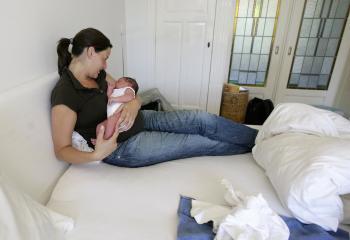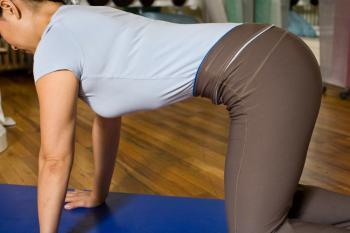The benefits of postpartum exercise are numerous, but a new kind of exercise may soon be the top choice for new moms. That choice is corrective exercise, which means using the right muscles for the right job.
There are a few muscle imbalances or misalignments that nearly every new mom will have. How fast she rebalances her alignment determines how many aches and pains she'll develop as she adapts to carrying a rapidly growing infant
The first three imbalances involve the use of her core, hips, and muscles around the shoulder blades. After months of pregnancy and then birth, these muscles are not working well. This can manifest itself through a variety of pains in the back, knees, neck, hip, pelvic, area, feet, and even through shin splints.
If the proper muscles are not reactivated, these pains will eventually manifest as headaches, degenerative disc syndromes, tendonitis, arthritis, and multiple other syndromes that often seem unavoidable.
As a health coach with more than a decade of experience in corrective exercise, I have found that three simple corrections will solve about 80 percent, in number or severity, of the pains and syndromes I mentioned. As with any health-related advice, a visit to your physical therapist, doctor, or qualified exercise specialist can help identify if you need more specific treatment.
Wake Up the Core
Postpartum women will tend to have underactive core muscles. The diaphragm and transverse abdominus (TVA) will most likely not work well. The TVA is a deep abdominal muscle responsible for flattening the abs and stabilizing the hips and lower back. If a cesarean section has occurred, the TVA will be in special need of rehabilitation. The pelvic floor muscles are usually traumatized from vaginal birth.
A new mom must learn to naturally inhale deeply with her diaphragm, seemingly filling her belly and ribs with air. During exhalation, the lower abdomen and waistline should be encouraged to naturally move inward, re-engaging the TVA as her natural corset. A reawakening practice of Kegel exercises will re-establish awareness in the pelvic floor.
Every time a new mom bends over to pick up her child, exercises, gets up out of a chair, or performs a movement of any kind, she must charge her core by breathing through the difficult sticking point of the movement. This is “belly pumping.” Without it, the new mother’s core muscles, including her diaphragm, will get weaker.
In other words, use the belly to help you move. Use it or lose it.
Avoid Back Strain
Postnatal women are extremely likely to overuse their lower back or knees. Their buttock muscles are often not working well for them. A new mother is often trying to do many things at once while holding her delicate baby and picking up the diaper bag or car seat, and so is likely to hurt her back if she is overusing it.
Postnatal women are extremely likely to spend hours slouching as they nurse their infants. Little do they realize that they are also nursing a collection of neck, back, and shoulder problems. In order to “stand up straight,” think of bringing your shoulder blades together. Be careful not to tense the neck or shoulders too much.
Putting It All Together
Pregnancy and postpartum periods tend to exacerbate whatever imbalances already existed. Add to this the fact that the majority of women will have a surgery of some sort during delivery, and the stage is set for significant postpartum musculoskeletal problems.
A simple, no-cost, and multibeneficial answer is to establish a daily routine of corrective exercise. When you exercise, make sure you use your upper back by drawing your shoulder blades together, use your abdominal muscles by breathing properly and drawing your navel in toward your spine, and use your buttock muscles by bending properly from your hips.
You can also follow an exercise DVD at home. Just make sure to remember the basic three corrections above. Spend a minimum of five minutes, or enjoy a full exercise session, but make sure to plan a focused time for your practice.
To apply this in your daily life, think about using your abs and your hips when you are standing up from the couch. When you bend to pick up your little one, engage your core muscles, and don’t round your shoulders.
Be more present, and take notice of movement habits. Soon, these foundational corrections will become automatic, and you will be solving your own aches and pains. Begin this change now, and you'll be securing your right to enjoy many more pain-free activities throughout the growing years of all your children.





